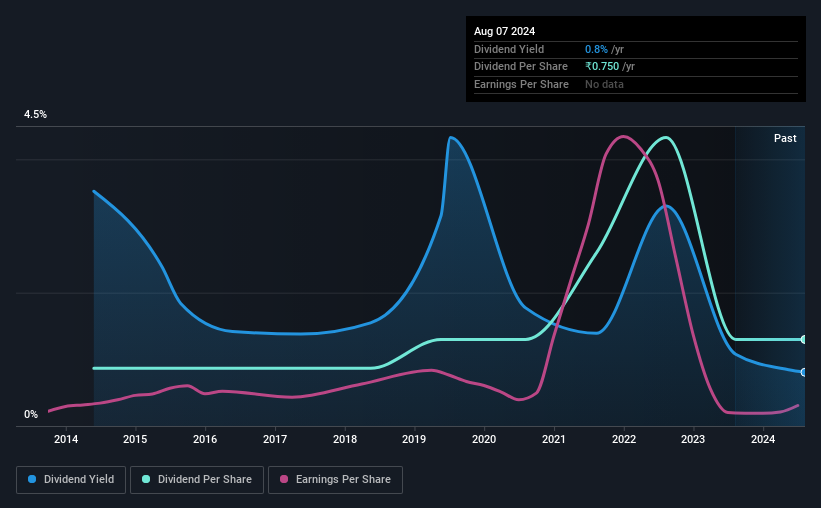Manali Petrochemicals (NSE:MANALIPETC) Has Affirmed Its Dividend Of ₹0.75

Manali Petrochemicals Limited's (NSE:MANALIPETC) investors are due to receive a payment of ₹0.75 per share on 18th of October. This payment means that the dividend yield will be 0.8%, which is around the industry average.
Check out our latest analysis for Manali Petrochemicals
Manali Petrochemicals' Dividend Is Well Covered By Earnings
We aren't too impressed by dividend yields unless they can be sustained over time. The last dividend was quite easily covered by Manali Petrochemicals' earnings. This indicates that a lot of the earnings are being reinvested into the business, with the aim of fueling growth.
Unless the company can turn things around, EPS could fall by 16.7% over the next year. Assuming the dividend continues along recent trends, we believe the payout ratio could be 61%, which we are pretty comfortable with and we think is feasible on an earnings basis.

Dividend Volatility
Although the company has a long dividend history, it has been cut at least once in the last 10 years. The dividend has gone from an annual total of ₹0.50 in 2014 to the most recent total annual payment of ₹0.75. This works out to be a compound annual growth rate (CAGR) of approximately 4.1% a year over that time. We're glad to see the dividend has risen, but with a limited rate of growth and fluctuations in the payments the total shareholder return may be limited.
The Dividend Has Limited Growth Potential
Growing earnings per share could be a mitigating factor when considering the past fluctuations in the dividend. Earnings per share has been sinking by 17% over the last five years. A sharp decline in earnings per share is not great from from a dividend perspective. Even conservative payout ratios can come under pressure if earnings fall far enough.
Our Thoughts On Manali Petrochemicals' Dividend
Overall, we don't think this company makes a great dividend stock, even though the dividend wasn't cut this year. The payments haven't been particularly stable and we don't see huge growth potential, but with the dividend well covered by cash flows it could prove to be reliable over the short term. We would probably look elsewhere for an income investment.
Companies possessing a stable dividend policy will likely enjoy greater investor interest than those suffering from a more inconsistent approach. However, there are other things to consider for investors when analysing stock performance. Just as an example, we've come across 2 warning signs for Manali Petrochemicals you should be aware of, and 1 of them makes us a bit uncomfortable. Looking for more high-yielding dividend ideas? Try our collection of strong dividend payers.
New: Manage All Your Stock Portfolios in One Place
We've created the ultimate portfolio companion for stock investors, and it's free.
• Connect an unlimited number of Portfolios and see your total in one currency
• Be alerted to new Warning Signs or Risks via email or mobile
• Track the Fair Value of your stocks
Have feedback on this article? Concerned about the content? Get in touch with us directly. Alternatively, email editorial-team (at) simplywallst.com.
This article by Simply Wall St is general in nature. We provide commentary based on historical data and analyst forecasts only using an unbiased methodology and our articles are not intended to be financial advice. It does not constitute a recommendation to buy or sell any stock, and does not take account of your objectives, or your financial situation. We aim to bring you long-term focused analysis driven by fundamental data. Note that our analysis may not factor in the latest price-sensitive company announcements or qualitative material. Simply Wall St has no position in any stocks mentioned.
Have feedback on this article? Concerned about the content? Get in touch with us directly. Alternatively, email editorial-team@simplywallst.com
About NSEI:MANALIPETC
Manali Petrochemicals
Manufactures and sells petrochemical products in India, the United Kingdom, and internationally.
Excellent balance sheet average dividend payer.
Market Insights
Community Narratives




